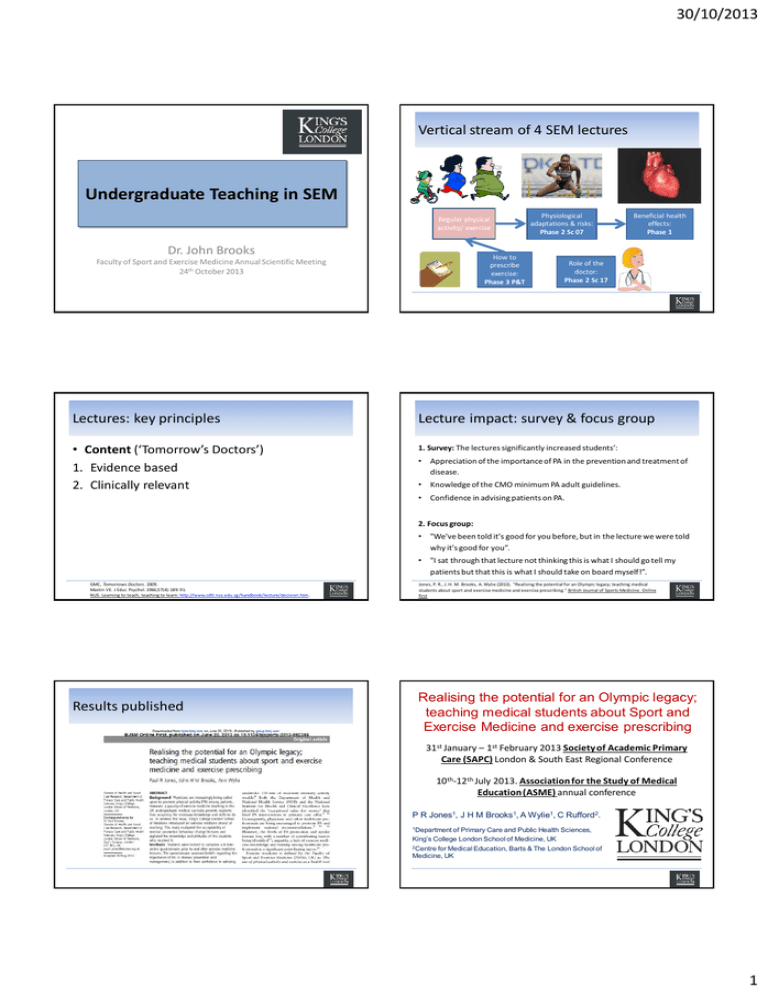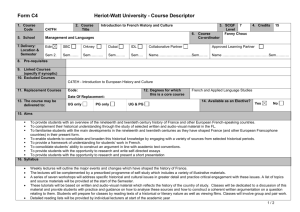Undergraduate Teaching in SEM
advertisement

30/10/2013 Vertical stream of 4 SEM lectures Undergraduate Teaching in SEM Regular physical activity/ exercise Dr. John Brooks How to prescribe exercise: Phase 3 P&T Faculty of Sport and Exercise Medicine Annual Scientific Meeting 24th October 2013 Physiological adaptations & risks: Phase 2 Sc 07 Beneficial health effects: Phase 1 Role of the doctor: Phase 2 Sc 17 Lectures: key principles Lecture impact: survey & focus group • Content (‘Tomorrow’s Doctors’) 1. Evidence based 2. Clinically relevant 1. Survey: The lectures significantly increased students’: • Appreciation of the importance of PA in the prevention and treatment of disease. • Knowledge of the CMO minimum PA adult guidelines. • Confidence in advising patients on PA. 2. Focus group: • "We've been told it's good for you before, but in the lecture we were told why it's good for you”. • "I sat through that lecture not thinking this is what I should go tell my patients but that this is what I should take on board myself!”. GMC, Tomorrows Doctors. 2009. Mastin VE. J Educ Psychol. 1966;57(4):189-91. NUS. Learning to teach, teaching to learn: http://www.cdtl.nus.edu.sg/handbook/lecture/decision.htm. Results published Jones, P. R., J. H. M. Brooks, A. Wylie (2013). "Realising the potential for an Olympic legacy; teaching medical students about sport and exercise medicine and exercise prescribing." British Journal of Sports Medicine. Online first Realising the potential for an Olympic legacy; teaching medical students about Sport and Exercise Medicine and exercise prescribing 31st January – 1st February 2013 Society of Academic Primary Care (SAPC) London & South East Regional Conference 10th-12th July 2013. Association for the Study of Medical Education (ASME) annual conference P R Jones1, J H M Brooks1, A Wylie1, C Rufford2. 1Department of Primary Care and Public Health Sciences, King’s College London School of Medicine, UK 2Centre for Medical Education, Barts & The London School of Medicine, UK 1 30/10/2013 Exam questions • 15 questions approved & in the question bank for phase 1-3 (summative assessments) Recommended additions to the medical curriculum - example • Chest pain – Basic and pathological sciences • Physiology – Adaptations to regular physical activity and exercise – Clinical Sciences • Management – Treatment of hypertension, hyperlipidaemia, diabetes, Correction of risk factors-smoking, physical inactivity overweight, diet and alcohol – Communication: • Starting physical activity and exercise – Public health sciences: • Physical activity, exercise and public health – Community/ primary care: • Assessing levels of physical activity and exercise • Advising safe physical activity and exercise for health Addressing issue of limited clinical exposure for students Obesity day: Enabling tomorrow’s doctors to consult obesity (1st May 2013) • GP teachers (25% of teaching practices) • Workshop: Prescribing physical activity and exercise (Dr. Chris Rufford & Dr. John Brooks) J H M Brooks, A Wylie, C Rufford, P R Jones 3-5th July 2013 Society of Academic Primary Care Annual conference University of Nottingham. Title: Teaching medical students about exercise prescription. Courtesy of Dr. Ann Wylie & Dr. Kay Leedham-Green Now established, what about the future …………? Why is this important? 1. Phase 4: Sports medicine (+ exercise medicine reminder) • Specialty awareness 2. Phase 5: Lecture or workshop • Evidence based education: importance of physical activity for health + MSK injury management 3. SEM SSCs 4. US using a similar outline (anecdotal) • Population health 5. Other UK Medical Schools …….. 2 30/10/2013 Expanding SEM teaching to other medical schools Potential issues & solutions • Explicit recommendations from Royal College of Physicians • 56% of medical schools (average of 4hrs) (2010/11) 1. Issue: No staff to deliver SEM teaching • Solutions: Undergraduate SEM committee (Dr. Simon Till): 1. Determine the extent of SEM undergraduate teaching 2. Write core curriculum (based on King’s model?) 3. Agreement from faculty about the content 4. Contact medical schools with curriculum recommendations: – Their responsibility to source teachers & draft teaching materials – FSEM to recommend local FSEM practitioners – FSEM to advise about linking with other specialties (eg. Primary care for behaviour change, orthopaedics for MSK) 2. Issue: No expert or time to draft resources • Solutions: – Selection of FSEM slides or lectures to use – Pre-recorded FSEM lectures – (Would need Faculty approval & regular updating) Royal College of Physicians (2012). Exercise for life: Let’s Get Moving Weiler, R.et al. (2012). BJSM e 46(14): 1024-26 Potential issues & solutions Summary – possible actions points 3. Issue: SEM still not taught (or not taught well) • Solution: 1. Determine the extent of SEM undergraduate teaching – Online CPD for undergraduates & other medical professionals (FSEM or BMJ Learning) – (Would need Faculty approval & regular updating) 4. Issue: Students not exposed to exercise medicine clinically • Solution: – King’s GP training day? Acknowledgements 2. Write & agree core curriculum by Faculty 3. Contact medical schools with curriculum recommendations 4. Follow-up to ensure teaching is happening (Deans or local medical students) 5. Online CPD resource? Thank you: questions/ discussion • Dr. Simon Till • King’s: – – – – – – – – Dr. Ann Wylie Dr. Paul R. Jones Dr. Despo Papachristodoulou & Dr. Liz Andrews Prof. Albert Ferro & Dr. Teifion Davies Prof. Janice Rymer Simon Power Dr. Kay Leedham-Green Dr. Ron Jacobs John.h.brooks@kcl.ac.uk 3
